#Producers Guild Association
Explore tagged Tumblr posts
Text
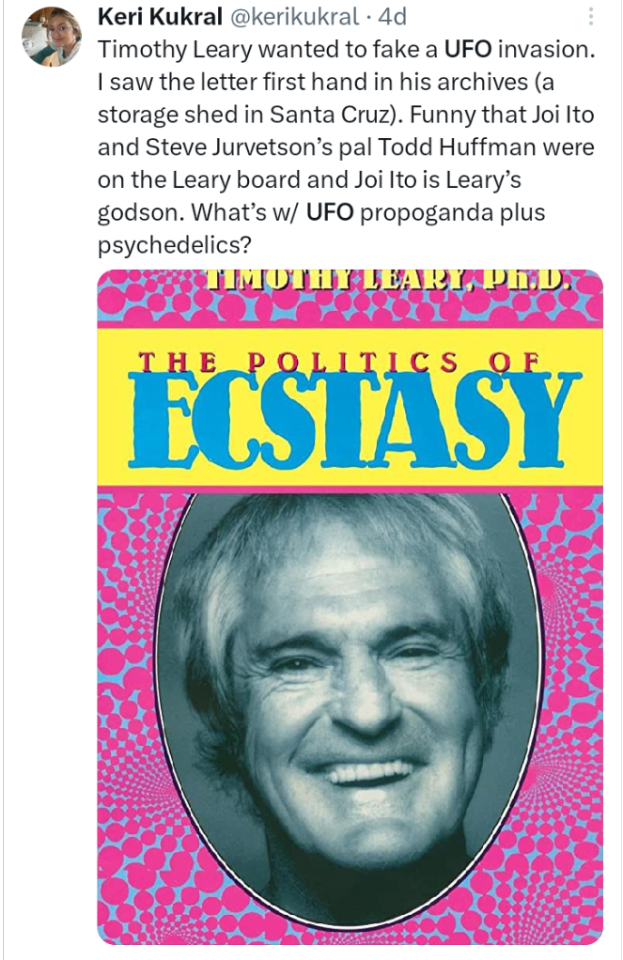

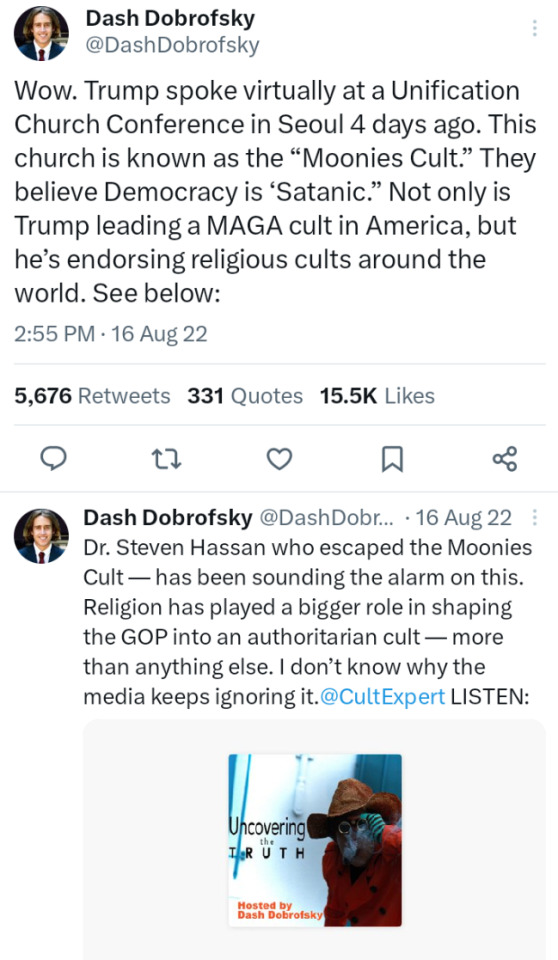

"Looking back, I’ve been researching this UFO crew since at least 2007, very directly. UFO cultist Steven Greer met his wife Emily in Israel studying with meditation guru Maharishi. This is all tied to David Lynch and the related transcendental meditation (TM) groups. 🧵
This relevant now because his UFO cultist cohort Dennis Kucinich is now managing RFK Jr’s presidential campaign. Kucinich ran for POTUS in 2007 on a UFO platform based out of none other than… Sheldon Adelson’s Las Vegas, NV.
John Hagelin runs the Maharishi meditation organization out of LA. Hagelin "is a theoretical physicist who ran for the U.S. presidency three times on the Maharishi-backed Natural Law Party" (1992, 1996, 2000).”
In 2000 race he was backed by the Perot faction and disrupted Pat Buchanon. In 2004 he handed the ropes over and endorsed Kucinich.
This same culty, meditation, UFO crew has been trying to run for POTUS for nearly 20 years. It continues through today with RFK Jr.
Is it a coincidence that people threatening President Biden via his son Hunter, suggesting he is “stealing the election” per a hooker they know? I don’t think it is at all. This group is assaulting the US democracy and the integrity of the office of the President.
I think they’ve been storming the US Presidential position since the fall of the Soviet Union, using propaganda, cults, misinformation, and sadly via trying to compromise the sons of US presidents from JFK to Hunter Biden.
Maharishi seems like Indian intelligence. A lot of these 1970s new age space gurus interacted with these “space love sex LSD” guru types for decades. Is it a coincidence that Howard Bloom has worked with Modhi on space initiatives for DECADES?
Is it a coincidence that I know Howard Bloom and that he and Moonie NEWT GINGRICH were advocating for a moon colony during the Trump Admin? Can I sound any… crazier? 🤣 Reality is stranger than any fiction.
Newt Gingrich trying to sell Trump on a cheap moon plan A general, Gingrich and Michael Jackson's publicist are proposing a $2 billion contest to return Americans to the moon.
Why is Jeff Bezos pushing this UFO propaganda with Harvard and the Luis Elizondo guy? See the L5 Society hippy space cult shit. Both Bezos and Newt were part of that since teenagers (I think, find the reference.) L5 Society is connected to Timothy Leary and the usual suspects.
This all looks to me like a BRICS assault on the US Presidency and space industry since literally JFK challenged us to go to the moon. End thread."
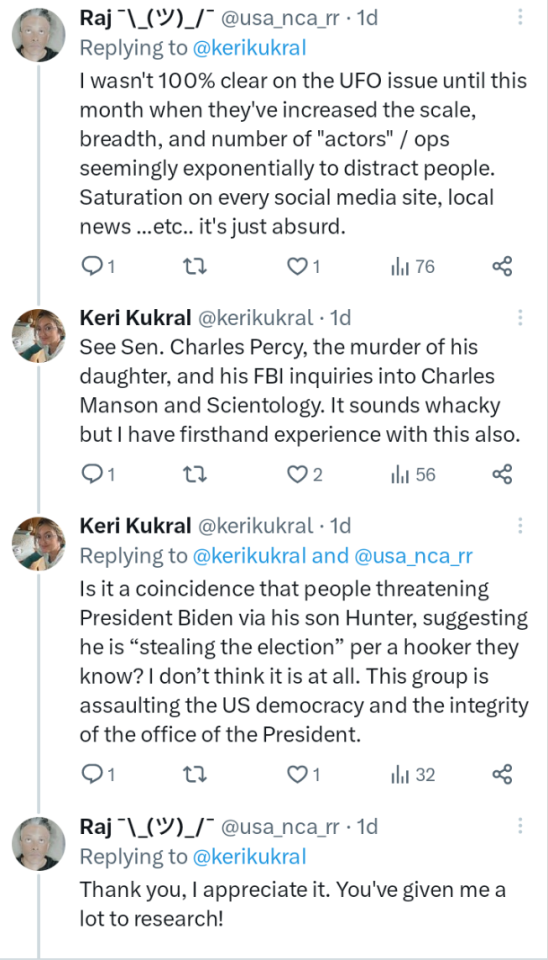
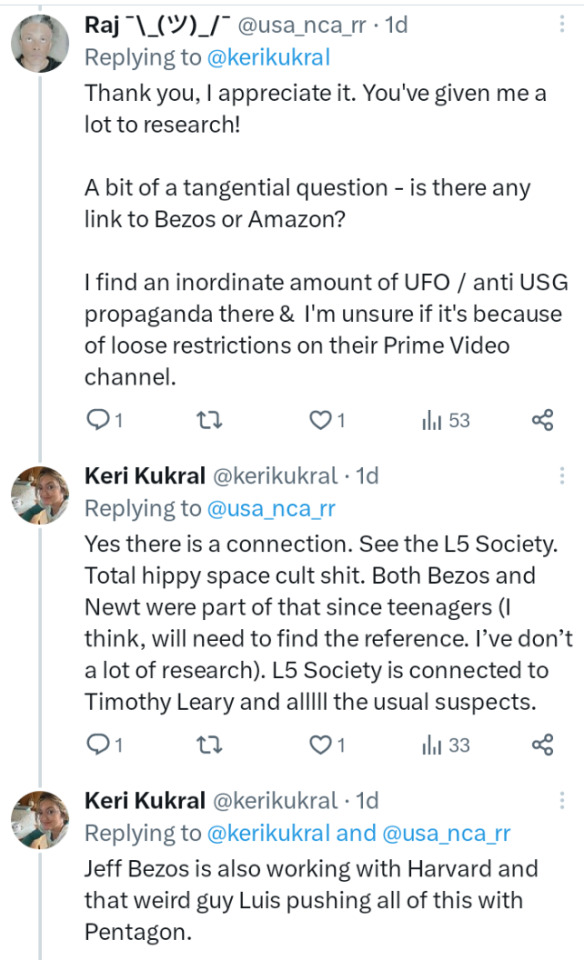
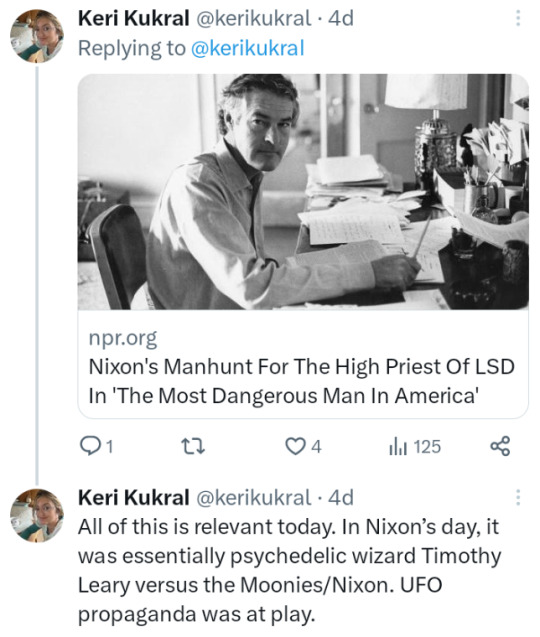
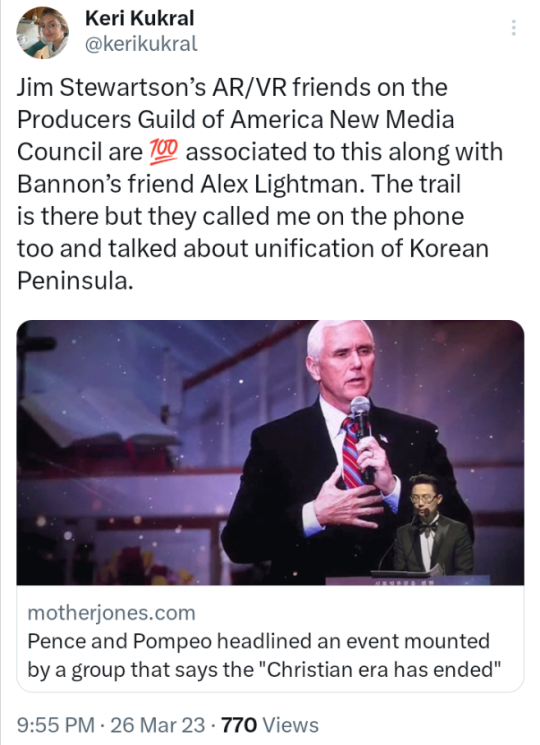

Kukral even knew these 🌙 cults would try this. What is it with all of these cults? I'll just take a wild guess the Moonies came from yet another Freemasons group and no surprise that it considers Democracy Satanic. Projection as big as the Empire State building. I can't believe it hasn't occurred to people these objects probably came from some mad scientist and his billionaire backers. That's where we are, now.
#Producers Guild Association#PGA#Timothy Leary#Moonies#Jeff Bezos turbs out to be exactly the the nut I thought he was#Dr Hassan#UFO sightings as anti-Democratic hoax#Newt Gingrich#Robert F Kennedy#Alien myth started out as a white supremacy notion to explain the Egyptian pyramids and I was told it's not seem that way anymore. Well#It's certainly used that way#L5 Society
1 note
·
View note
Text
Incredible Weekend at Box Office from 11 to 13 August: Jailer, Gadar 2, OMG 2 and Bhola Shankar Created All time History!
Incredible Weekend at Box Office from 11 to 13 August: Jailer 2, which was Released on August 10, and all three films, Gadar 2, Omg 2, and Bhola Shankar, were Released on August 11 and Had a Good opening as well. Jailer opened with a sensational collection ₹ 96.60 Cr, and in 3 days from 11 to 13, the film earned ₹ 176.70 Cr, Gadar 2 garnered ₹ 159.00 Cr, Bhola Shankar grossed ₹ 31.10 Cr, And OMG…

View On WordPress
0 notes
Text
Settle in with me
Part 1 <- Part 2 -> Part 3



After the results of the programme in hopes of producing future hunters, Jinwoo takes the lead.

Yandere!Jinwoo Sung x Fem Hunter!reader Tags - mentions of breeding,Dirty thoughts,Jealousy,kissing,Jinwoo really wants to fuck you,Forced pairing for breeding,Kinda role playing,Little mentions of squirting and other sexual acts,Mentions of pregnancy and impregnation
<<< For more Dark/Yandere content, click this link to go back to the Masterlist! >>>
<<< Or back to this fic's Master list. >>>


The results of the pairings had been delayed due to a tragedy.
“We apologise for the delay, due to the loss of one of our association members, we had to wait until we could access the sensitive information. A formal enquiry is being made in the meantime and it’s being treated as suspicious.”
“To think we had such bad news right on our doorstep. At a time like this too.” Hunter Choi took off his glasses and cleaned them with dismay and pursed lips.
Jinwoo walked right through without issue for that information. Stealth made it way too easy. Still, he feigned surprise. “Why would someone do that? It doesn’t make sense.”
You remained silent, spacing out at the table, sitting next to Jinwoo this time. Baek slammed his fist on the table and it never even made you flinch. “Of course it makes no sense, it’s just information on who’s sleeping with who essentially-”
“Please, don’t be so crude.” Hunter Cha snapped, wiping away the invisible smell with her handkerchief. “We’re all affected by this, a man is dead. And… we’re all affected.” Her voice trailed off, she realised her outburst was seen by everyone, including the Chairman.
Jinwoo sat back and watched, awaiting the news with the excitement of carrying out his year-long quest. He’d have you soon enough, he only hoped you would do so willingly.
“Can we… Can we just get this over with now while the investigation is underway? I’d really like to go now.” You said, finally participating, fiddling with your fingers under the table because you just didn’t know what to do with yourself.
“I think so too.” Jinwoo interjected the tension and flashed you a sympathetic look. “There’s nothing we can do right now and I think we’d all like to get on with things so we can settle in, right?”
“Exactly, Hunter Sung, while we can grieve those who make the Hunters association smooth like a machine, we must carry on.” Chairman Go pulled out a sheet of paper, a small one at that, practically insignificant. “I have here the latest results for the trial period of S-Ranked Hunters set to participate in the programme, I’ll read it out as follows.”
Jinwoo picked up on your heightened breathing immediately, trembling fingers knotted together and holding on for dear life. Anticipating the future of the Hunter’s association.
“Hunter Cha will be paired with Hunter Choi. Which leaves…” When your name graced the Chairman’s lips, you watched the man’s soft facade with anticipation. “You will be paired with Hunter Sung.”
There was nothing to be said about the elephant in the room, well, the entire room was the elephant. Jinwoo sat with a wash of relief though stifled it for now. A matter of hours and he’d potentially be balls deep inside you ready to blow his first load inside you… for the good of the association, the country, his fellow Hunters and guild members.
“This will be effective immediately, so you should gather your things and return to headquarters later tonight for your keys and accommodation. I am appreciative of all the hard work you do and what more you’ll be sacrificing for this country and the association.”
Jinwoo liked the ring to that, effective immediately.
After the Chairman left, Baek slouched back into his chair and whistled. “I wasn’t sure which one of us it was going to be, but I didn’t think it would be both of you. Ugh, things are going to get weird around here.”
Choi was naturally flustered, but his rivalry with Baek pushed past the initial shock. “I think it’s a valiant effort, maybe that’s why you weren’t asked to do it. Nevermind.”
Baek growled. “Watch it buddy-”
“Ugh, was there any point in us even being here? I came all this way for nothing.” Hunter Lim had not said one word the entire meeting, shrugging off whatever words and consternation entered the room. He and Hunter Ma were not present the last time the S-Rank hunters were together.
Hunter Ma sat watching the two boil over in their feud. “I guess we just gotta do it then, no point in fightin’ amongst ourselves.”
You and Cha were silent, unmoving and weighted down in the boardroom chairs, the gravity of it all getting more heavy with each ragged breath amongst the inhouse fighting.
Jinwoo never took your silence as an insult, in honesty, he never wanted it to be this way between you and him. He hoped with time you’d take to him as much as he understood Cha was with him. The bonus being that it would just accelerate things and give him a head start on his quest.
“You think you’re the shit now because you might have an S-Rank baby? Heh, we’ll see about that.”
“Guys, stop it!” Banging your fist on the table got Choi and Baek to stop their squabbling temporarily, everyone looked right at you in pin drop silence. “This is hard enough as it is without you two fighting. Things are going to change around here and we have to just… get used to it. Please don’t make this any more complicated than it has to be.”
Then, you walked out, taking Hunter Cha with you.
Now, the men pouted or sat around in the swivel chairs waiting for someone to speak and break the silence.
“I bet you’re happy, huh, Jinwoo?” Lim rested his chin on his balled fist over the table. “She’s pretty, but doesn’t Jong-In have a crush on her?”
“Uh… hold on a second.” Choi adjusted his glasses and cleared the truth from him throat awkwardly. “Firstly, a crush? We’re adults. Secondly, I admit to no such thing, we’re quite good friends, actually. It’s quite that simple and while I think I would have suited her well, the computer chose Hunter Sung, so I won’t protest. Thirdly, although not lastly, Hunter Cha is also a good candidate, gentlemen.”
Jinwoo noticed the mild resentment behind his mask, it slipped ever so slightly before regaining its control of his face again. Jong-In Choi was a kind man, everybody knew that, the goodness in his soul was something Jinwoo admired from time to time. A trait he wouldn’t ever fully grasp again after slipping between the line of right and wrong.
But man, was he easy to read.
The association member Jinwoo killed wasn’t the first man, he also wasn’t remorseful in the slightest at the sight of his dead body on the ground. Although he hoped it wasn’t necessary, it was to secure your name. So all in all, not a wasted journey.
Murder… A trait he gained in which he hoped to work on, but recently, Jinwoo found himself wanting to leave it fester. That’s where all of his sudden intrusive thoughts showed themselves. Although right now, seeing Choi so flustered over you should make him want to do something to the man, even if it was just harsh words for the time being, what saved him was having you paired with him and not Choi. The saving grace in this scenario. Something he could inaudibly shove in his face and no one be none the wiser.
But he knew if push came to shove, he could kill Choi easy.
Jinwoo smiled sweetly to the room. “Well, while it’s unorthodox they want us to do this, I know me and her will make a good team, just like Hunter Cha and Choi will.”
“A true political answer, good job, Jinwoo.” Lim patted him in the back and threw his hands in his pockets. “But I’m out of here now so enjoy doing whatever in the bedroom.”
“You’re leaving already?” Baek stopped any annoyance and rolled his chair away from Choi a fraction and studied Hunter Lim’s relaxed trudge towards the door.
“Yeah, There was no point us being here if they weren’t going to pair us off with any of the A-Ranks at least or something, they really only needed Jong-In and Jinwoo for the announcement. No one wants to know what sort of kinky stuff they’ll be getting up to, we just continue life as normal. And I have a guild to run, see ya.”
“What’s up with that guy today?”
“He’s right, I gotta guild to run too, see ya!” Ma strolled out of the room without putting his two pence in and closed the door behind him with an untenable pressure pulsing with uncertainty.
“I guess I’ll go too then. I have to go and pack.” Jinwoo stood up without much resistance from the other two.
“I’ll see you later then, Hunter Sung.” Choi smoothed down his suit and left it at that.
Jinwoo walked through headquarters with elation, holding back his smile as soon as he heard you talking with Cha in the hallway. He stopped and listened in the shadows with stealth, not that you would be fooled by that at all. Your perception was far too high.
“It’ll be alright, because we’ll do this together. Shit… okay, okay. We’ll do this, one kid and we’ll bow out. That’s what the chairman said.”
Cha was panicked, trying to control her breathing from behind the stairwell. “Is this really the right thing, though? I can’t help but feel used. How could I look at a baby and just give it away?”
You however, were much calmer, like you had accepted your future path. “You’re right, I feel the same way. At least you’ll be with Jong-In, he’s a real sweet guy. I’m… I’m sorry you weren’t put with Jinwoo. I know you like him.”
Hae-In Cha made her obvious feelings subtle to everyone else, but Jinwoo saw right through them given enough time. He kept it secret, chasing you instead and giving Cha no reason to extend that olive branch. Jinwoo just wasn’t interested. She was a skilled S-Rank hunter for sure, impressive and beautiful, but you… you were something else. And still exploring your abilities to this day.
A point Jinwoo rarely brought up in his mind, that you were incredibly useful to him.
Cha’s breath stuck in her throat, Jinwoo stepped closer to see her expression. “Uh… n-no! I don’t- I mean… well, yeah, I kind of do. But there’s nothing to be done about it. It’s just sex, right?”
Wrong . It wasn’t just sex, not for Jinwoo.
You went in to speak but hesitated, turning your head in Jinwoo’s direction with a scowl, you just missed him.
“What is it?” Cha questioned, her tone softer than before.
“Uh… I-I’m not sure, I thought I saw- listen, just think of it that way. It’s just sex, and hopefully we can do this as quickly as possible. No growing pains, just our jobs. Together, alright?”
It wasn’t just sex. Jinwoo would make that clear every time he fucked you, made you come and forced his name on your lips so loud Jong-In Choi would hear down the hall.
And by that night, when Jinwoo heard the requirements for the programme, ‘At least three times a week, but most nights if you can, depending on your schedules. We’ll try to make them less conflicting as possible’.
Yeah, life looked pretty interesting from here on out.
He’d fuck you every night, no problem, to train you to see just how much you needed him despite your independence.
When the door of the little apartment on top of headquarters closed for the first time behind you, Jinwoo’s web had started weaving. You were so beautiful in the moonlight of the darkened apartment, saying goodbye to Jong-In and Hae-In as they disappeared into their own space. It was more intimate now among the S-Ranks, using first names wholeheartedly like neighbours and friends instead of hunters.
It was all very domesticated.
“So…” You said, clearly ruminating on the path that brought you here.
Jinwoo could see it in your eyes, that doe eyed little stare anxiously darting about the room and everywhere but him.
“So… Uh, you can look at me, y’know?” Jinwo wanted you to look at him the way Jong-In looked at you.
He made it his personal quest, and seeing the system's quest progress unmoved bothered him. Not the best start to an evening, he wondered how to bring you more at ease. Jinwoo waited this long to be in this type of situation and he wasn’t giving up with the opportunity of fucking you senseless and having you all to himself.
“S-sorry, I just don’t really know where to go from here without making it weird.”
Awkward, pressured, even artificial? Maybe. Weird? Never.
“Is this your first time, or?”
You struggled to stifle your gasp in the dark room and shuffled about a bit. “What? N-no I’ve had sex before, Jinwoo.”
He rubbed his neck and feigned embarrassment. “Sorry- bad start. I just wanted to gauge your boundaries. I don’t want to cross any unintentionally.”
More than I already have. That’ll come with time, then she'll be thanking me for doing it.
“Ah crap… what the fuck, Jinwoo. I never thought we’d be in this position.” Hearing your sweet huff of that bratty frustration he knew you were capable of turned him on. “Hae-In really likes you- but you can’t say anything because she made me promise not to tell you, but this feels wrong… it feels…”
What words would you utter? Jinwoo would use perfect, or extraordinary. Nothing negative like you wanted to use.
“She likes you. It’s like I’m betraying her.”
“Look.” Jinwoo changed the subject immediately, thinking of ways to change your mind without his influence. “Why don’t we forget about everything outside, and just focus on what’s going on in here? We could pretend that we just had a really awesome date, I asked you back to my place and you said yes.”
“Like roleplaying?” Exactly.
He nodded like you could see him properly. “It might ease your nerves.”
“A-alright… but can we leave the lights off? I’m not sure I want that right now.”
“Of course. Anything you want.”
Jinwoo heard your steps draw nearer, closer until you were near enough to take you right then and there if you let him. He’d pick you up and carry you over to the open planned kitchen counter and fuck you with your knees close to your chest.
Fuck. I have to try that sometime.
“So…” You said again, tugging on his jacket to get his role played attention. “Thanks for this. I mean it…”
Jinwoo sensed you were trying to get in character, he took the lead like most things in this relationship were going to develop. “Thanks for tonight, I had a great time, I wasn’t sure you were going to come up here. I’m glad you changed your mind.”
“I did want to. It’s just… I haven’t done this with many people so I’m a little nervous.”
He took our chin with his thumb and forefinger, trying not to smile at your quick inhale. “It’s alright. I can lead you through it, how does that sound?”
“Yes. Yes please.”
“I think it’ll be better if we kiss a little first, do you want to?”
When you nodded and allowed yourself to get close, your lips were everything Jinwoo had wondered about. So supple, warm and plump enough to suck on, to bite and pull. He could tell you were reluctant, wooden with your position with your hands still enough to pass for a marble statue. So Jinwoo took your hands between his fingers, small enough for one hand whilst the other ran through your hair and brought you closer than before.
Your tongue drowned him in his lust he was so desperately holding back, to not let his urges spoil you before he had a chance to earn your trust completely. Jinwoo wanted to ruin you until you couldn’t speak coherently and only communicated in murmurs and babbling because of a multiple orgasm streak that got you squirting all over his face.
And then you pulled away from him. For a second there, he thought you were backing out of it. But then you said, “Will you look after me, Jinwoo? I’m scared.”
Jinwoo took an educated guess and assumed it was the tough stuff, the pregnancy to come and all that other stuff. Well, of course it was, having mind bending sex wasn’t something to be frightened of. But getting you pregnant was something Jinwoo couldn’t join you with fear because it excited him, it turned him on something chronic.
And pregnancy sex? Sign him up.
He took your hand and walked off without consulting you, straight towards the bedroom. “Let’s get comfortable.”
“Jinwoo-”
“I’m going to look after you, I promise.”
His impromptu plan worked, he might have had innocent blood on his hands doing it, but he couldn’t wait to have something more precious in his hands for years to come and now that he had it, he wouldn’t let it go.
And that was you.

Part 1 <- Part 2 -> Part 3
If you would like to be tagged, please let me know! Thanks so much for all the support on this likes, reblog and comments appreciated! ❤️
Tag list - @bubera974,@snowy-violet,@sky2lar,@starrynights23x,@minh907
@yessirr7,@aussie-boys-wife,@yihona-san06
DISCLAIMER - Crossposted from my AO3 - I do not own any of the characters or anything from the anime or manhwa. This is a work of fan fiction and is absolutely not representative of the views or intentions of the original creator(s).
Also please don’t post any of my work without permission thank you!
#solo leveling au#solo leveling#solo leveling jinwoo#jinwoo sung#sung jin woo#x reader#fem reader#reader insert#smut in next chapter#WERE GETTING SMUT PEOPLE#sung jinwoo x you#jinwoo sung x reader#jinwoo x reader#jinwoo#sung jinwoo#sung jin woo x reader#lord#this few one shots might evolve into a proper fic#minors dni#minors do not interact#yandere jinwoo#yandere x darling#yandere#only i level up
478 notes
·
View notes
Text

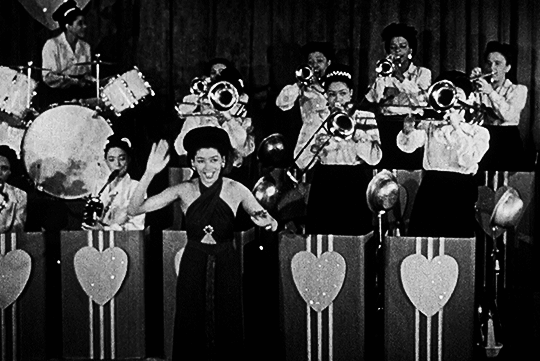
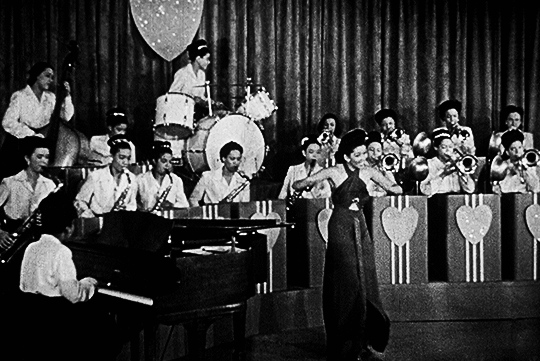
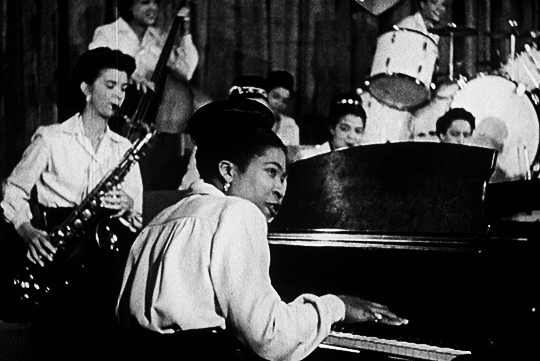
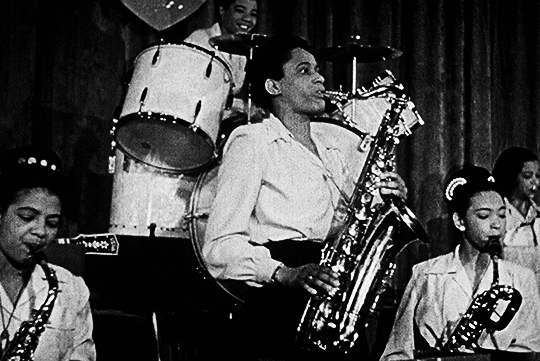

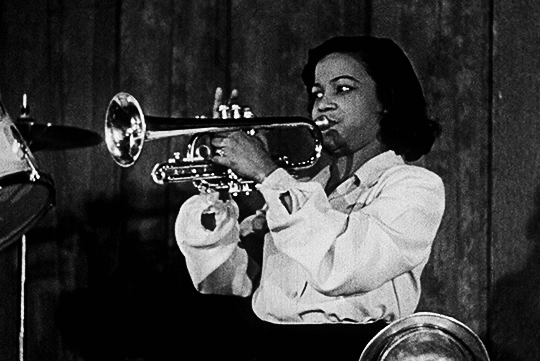
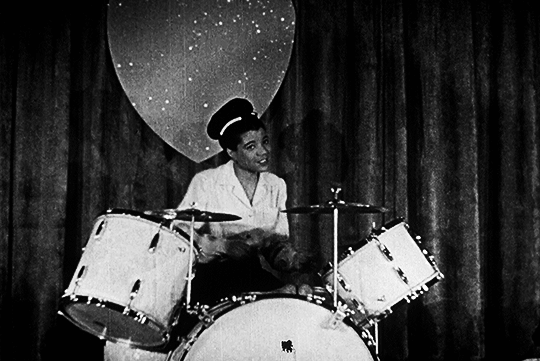
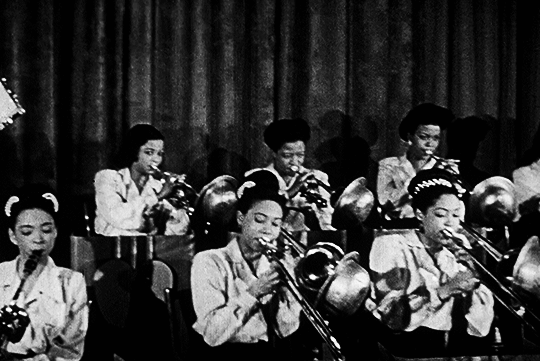
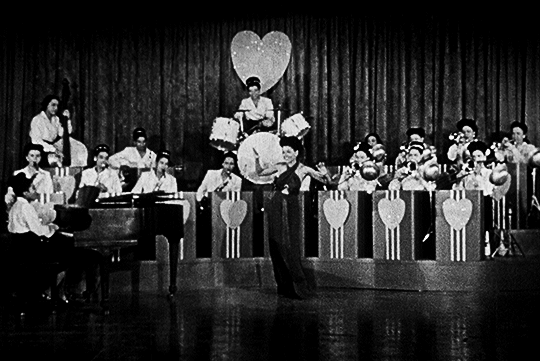
SHE'S CRAZY WITH THE HEAT — 1946 ft. The International Sweethearts of Rhythm
In 1946, William D. Alexander began the production of a series of one-reel shorts, half-hour featurettes and feature films that would serve a dual purpose. These black cast subjects would be released to theaters that welcomed African American audiences; concurrently, the music segments would be excerpted from the films and released as Soundies. Ultimately, sixteen of Alexander’s musical shorts reached the Panoram screen, spotlighting the bands of Lucky Millinder, Billy Eckstine, Henri Woode and the International Sweethearts of Rhythm. (Alexander actually produced four films with the Sweethearts, three ten-minute short subjects and one feature, although some of the performances turns up in more than one film; only three performances saw release as a Soundie.) The International Sweethearts of Rhythm grew out of a band formed in the 1930s at the Piney Woods Country Life School, an institution – in part an orphanage – for poor African American children. A member of the music department had apparently taken note of the success of Ina Ray Hutton’s Melodears and decided that an all-woman band composed of school members might lead to something special. While they performed locally, the ISR did not begin to hit its stride until it left Piney Woods and became a professional touring outfit in 1941. The band was certainly “international” in nature, and its ranks included African American, Latina, Chinese, Indian, White and Puerto Rican musicians. In 1941, Anna Mae Winburn joined the orchestra as front woman and featured vocalist. During the war years Maurice King joined the band as both arranger and band manager. Born Clarence King in 1911, King played reeds and later became a fine swing arranger. While here we recognize his composition and arrangement for the Sweethearts – he called this tune “She’s Crazy with the Heat ” – King is best known for his longtime association with Barry Gordy and Motown Records for which he served as director of artist development. He worked closely with vocal groups, teaching the singers how to voice and phrase together. “Maurice brought sophistication and class to Motown,” said session musician Johnny Trudell. By 1946, the Sweethearts was recognized as one of the finest African-American bands in jazz. They recorded for Guild and RCA Records, broadcast regularly for the Armed Forces Radio Service, and toured Europe entertaining the GIs. While much of the success was due to Maurice King’s arrangements, the band’s musicians were all strong, and a special nod must go to Viola Burnside, one of the most neglected tenor soloists of the 1940s. I chatted with my friend Roz Cron, a member of the Sweetheart’s reed section, shortly before her passing. When I thanked her for her contribution, she paused and said, “Yeah, we were one of the best, one of the very, very best.” (via Jazz on Film)
#classicfilmsource#femaledaily#filmedit#film#classicfilmedit#oldhollywoodedit#jazz#music#the international sweethearts of rhythm#she's crazy with the heat#1940s#mygifs*#soundies*
708 notes
·
View notes
Text
Chastity: Buggy
Birthday Celebration Masterlist
Word Count: 1,500+

Themes: Buggy x gn!reader, smut, mdni, 18+, NSFW, Buggy is in a chastity belt, you are tasked to dominate him, inappropriate use of devil fruit, creampie (Buggy receiving and giving), masturbation, bondage.
Notes: This clown has once again found his way back into my heart. I love him.

“Please.”
Sitting cross legged, reading over several new bounties produced and notated by Sir Crocodile in your plush, buttoned armchair, you pay the man on his knees no mind as he comes to terms with the circumstances that lead him to that moment.
Knees spread and thighs bound to his ankles beneath him, hands obediently lulled at his hips, neck tilted back and eyes watering with desperation, sat Buggy the Clown. The Face of Cross-Guild, chest heaving as his crotch was clapped in an iron belt and nothing else covering his body, was resolved into a heaving pile of flesh as his own cock buried itself into his puckered asshole.
He had not moved an inch since you first started this small amount of torture for him. Behaving as well as he could as you removed his cock and bound his legs, you had worked him with your fingers and lubricant while he was brought to the precipice of release without toppling over the edge.
Buggy was put through too much pain and markings at the hands of your boss, Dracule Mihawk, and his associate, Sir Crocodile. Being the face of an organization: beaten, battered and bruised was not in the best interest of the three of them when garnering popularity.
Under the guise that matters would be taken into your own hands regarding punishment and discipline, Mihawk placed the blue-haired clown in your charge to break him into submission.
This task was easier done than you had thought. A few choice words, simple heavy kisses, and the promise of a well-earned orgasm was enough to have the Clown immediately at your mercy.
“Not yet. I'm afraid you're just going to have to wait until I'm done with this page,” you utter honestly, taking your red, felt-tip pen to the parchment and slashing out an incorrect word. “If you didn't make so many mistakes, you could've been cumming inside yourself by now. But, fortunately for my own entertainment, you did.”
“Please,” he stuttered, tensing his bare abdomen as his blue-fuzz covered pectorals spasmed while he made to move forward. “Please, starlight. My cock has been shoved in my ass for over an hour. It's so fuckin-... Nghhmm-... It's warm, its tense, it's tight. Please let me cum?”
“No.”
“For fucks sake,” he whimpered, scrunching his paint-lined eyes shut while he attempted to rock his hips to no avail.
With the ropes binding his legs, and the iron belt holding his cock inside his ass, he had no way for friction to occur to bring him over that edge of ecstasy. He whimpered, his nipples pebbled and skin christened in beaded goose-flesh as he huffed and panted at the feeling.
“Calm yourself,” you uttered sharply down at him, pressing your covered toes on his bare chest while you scowled at him. “Honestly, have you no self control, clown?”
Buggy darted his teal eyes between yours, his bruises finally beginning to heal up and scars crust over from the beating days before that had this dynamic begin between you. Rolling your eyes, you remove your foot from his chest and peer once more down at the page.
“Please, Starlight,” he whimpered softly, “How much longer will you be? I-I-I need you. I need this. I nee-... I need-...”
Buffy's eyes took in every inch of you. Your toes, your ankles, your thighs, your crotch, your stomach, chest, arms, hands, face and head: all of those elements that made you distinctly you, Buggy was consumed by.
He didn't expect Mihawk’s former World Government Public Relations officer to stick with him after the disbandment of the warlords, yet here you were: slashing away at another wanted sign while he felt his need becoming almost painful. Nowhere near as painful as the beatings, but an ache enough to have him uncomfortable.
All Buggy wanted was to cum. Far from the initial embarrassment that came along with being naked with his own cock in his ass, he was feral for that one moment where you would release him from his chains and be permitted to ride his cock for your entertainment.
Finally complete with the pile of wanted posters, you placed the tan sheets at your side and tilted your head at the clown. His lengthy, blue eyelashes fluttered, his cerulean hair messy and clinging to his face and neck in bunches. His eyes were glazed, as was the shine from his rotund, red nose.
“Clown?” you spoke, breaking him out of his concentration and causing his ass to clench around himself. He groaned at the feeling, the edge still there after all this time.
“Y-Yes?” He stuttered. “Yes, Starlight?” Rapidly blinking, he focussed his attention onto you while attempting to remain perfectly still.
“I'm done with my work,” you nodded, uncurling your knees and switching your top-leg in front of him. Leaning down, you offer him the key to his belt in his hand, to which he shakily took it in his covered digits. “Be a good boy and put on a show for me?”
“Oh, fuck yes,” he uttered softly, his hands stumbling as he unclasped his chastity belt and watched as the iron slunk to the ground with a clang.
His thighs and ankles were still bound together, but his cock was now free to move with his Devil-Fruit powers. He wasted no time as the lubricant made sinking in and out of his puckered hole easier.
Each time his cock fucked itself in, his mushroomed tip hit his prostate and caused a small leak of precum to dribble from his slit. His tongue caught itself on the roof of his mouth while his shaft was squeezed by the tense of muscle around his skin.
“There you go,” you praised him with a soft click of your tongue. “Good boy, clown. I can see how close you're making yourself.”
“Uh huh,” Buggy uttered dumbly, his whole mind now focussed wholeheartedly on the show he was producing for you. He was a mess of moans, groans, mewls and whimpers as he desperately clawed his way to his release.
Soon enough, the clown began to bounce himself on his cock, eyes scrunched shut while he experienced everything all at once. Cock, ass, restriction, and filthy encouragement from your lips was more than enough to feel the call of his climax beckoning him into his oblivion.
“You gonna be a good boy and cum in that tight little hole of yours?” you purred at him, leaning forward and tapping his chin with your index finger, “Gonna cum on your own cock?”
Buffy's eyes fluttered open, peering down his nose at your lips and eyes as he rose and fell on his cock while fucking into himself from beneath him. The slickened ‘plaps’ grew more manic as he desperately found his high, eyes searching yours for that final wave of permission from you to topple him over.
“Show me, clown,” you taunt him, moving your lips to hover over his own, “Move those hands up and tease your nipples before I do. Grab onto them and cum all over and into yourself. Go on, clown. Show me how good you can be-.”
“-Ah, fuck-!” Buggy screamed, his voice cracking as he shot that first rope into his asshole. His cock slapped his prostate, the muscle causing his ecstasy to amplify as he felt his own ass milk himself of his release.
Reaching up, he clutched and clawed at his nipples while rocking up and down over his own cock in time of his released. Pawing at his pectorals, his face flushed a vibrant red while he cried out in euphoria.
Pearlescent ribbons fled his cock as his vision split white. He didn't know if he called your name, screamed out profanity, or simply shouted incohesive babbles while he painted his insides with his own cum. All he knew was he had never felt this pent up, this needy, and this good in some time.
Chest heaving, absent crotch shrouded in cerulean curls tensing, Buggy felt himself nearly pass out while he rode the tide his orgasm managed to swell inside himself. Before he could find himself falling onto the floor in a pile of bliss, you surged forward and caught his shoulders.
Immediately, your hands flung into action to unbind him of his ropes and fish out his own cock from being buried in his ass. You were not unaffected by his little display, but you forced your arousal back while tending to the aftercare needed by the face of Cross-Guild.
As you softly coax him back to the land of the living by wiping him down with pre-prepared towels and washcloths, Buggy peered at you with an unhinged glint in his eye. Unbeknownst to you, his hand popped from his wrist-link and slowly crept along the floor towards your thighs and crotch.
If you were going to have him beg and plead for release, without him able to do anything about it until you granted him permission, it was only fair he was to do the same to you.
And just as you finally met his gaze once again with your own, his digits disappeared down the front of your waistband and caused your breath to hitch in your throat.
“Your turn, Starlight,” he uttered sinisterly, his smirk ticking up in the corners of his lips and illuminating his face with mischief, “Now be good and put on a show for me.”
Tag list: @mfreedomstuff @daydreamer-in-training @since-im-already-here @gingernut1314 @writingmysanity @i-am-vita @indydonuts @feral-artistry @the-light-of-star @empirenowmp3 @racfoam @sunflowersatori @carrotsunshine @skullfacedlady @jintaka-hane @thenotsofantasticlifestory @jadeddangel
“Buggy-!”

🎶Happy Birthday to Me🎶
If you would like to celebrate by indulging my caffeine and bubble tea addiction, my Kofi link is here.
#one piece#x reader#2024 birthday event#buggy#buggy the clown#buggy the clown x reader#buggy smut#op buggy#one piece smut#buggy one piece#captain buggy#x gn!reader
167 notes
·
View notes
Note
I was wondering. Do you think that other writers and creators from Video games to comic books should join the writers strike?
Also a dumb out of the blue fun question: what do you think of Across the Spiderverse Miles and Gwen pairing?
No, the Writers Strike is members of the WGA (Writers Guild of America) striking against the AMPTP (Association of Motion Picture and Television Producers) companies. If other writers who don't write for films or television go on strike against other companies who don't make films or television then they aren't going to sway the AMPTP companies into giving the WGA a better contract.
1K notes
·
View notes
Text
Late in the day on Sunday, September 24 — after 146 days of labor stoppage, the longest strike in Hollywood history by a long shot — the Writers Guild of America (WGA), which represents Hollywood’s writers, and the Alliance of Motion Picture and Television Producers (AMPTP), an association of Hollywood’s largest studios and production companies, announced that an agreement had been reached. On Tuesday, September 26, the union’s leadership announced that they’d voted to end the strike and recommend the membership vote in favor of ratifying the contract.
#wga#wga strong#wgastrong#wga strike#wga strike 2023#hot strike summer#union strong#hollywood strike#news
899 notes
·
View notes
Text
[September 1] Don’t Fall For Hollywood Bosses’ New PR Spin
'Today marks the 122nd day of the Writers Guild of America (WGA) strike and 48th day of the Screen Actors Guild and American Federation of Television and Radio Artists (SAG-AFTRA) strike. The dual work stoppages have brought Hollywood to a standstill, with production halted on films and television programs, and premieres and other promotional events either scaled back or canceled. Both guilds are striking over demands that are more than reasonable, particularly given studio executives’ record pay. These demands include fair compensation for streaming media (particularly better residuals, which currently pale in comparison to what they are for network and cable broadcasts), robust studio support for health and retirement funds, and safeguards around the use of artificial intelligence. (For more on why WGA and SAG-AFTRA are on strike, read the excellent reporting of Jacobin’s Alex Press).
In a move that has shocked…pretty much no one, Hollywood bosses don’t want to share their earnings with the very storytellers responsible for generating them. At the same time, they’re happy to make workers pay the cost for their own miscalculations about streaming.
The major Tinseltown studios – organized under the Alliance of Motion Picture and Television Producers (AMPTP) trade association – remain stubbornly opposed to striking a fair deal with either guild. Under the leadership of AMPTP president Carol Lombardini, studios have employed brutal tactics to bust the strike, including threatening to drag things out until writers lose their homes and using management-friendly trade publications to pressure the guilds into accepting lowball offers. These tactics have backfired spectacularly: not only have they failed to end either strike, but they’ve also turned the public overwhelmingly against the AMPTP. A new Gallup poll finds that Americans back the WGA over the AMPTP by 72% to 19%, and SAG-AFTRA over AMPTP by 64% to 24%.
Aware of their reputational damage (but willfully ignorant of the anti-worker attitude that caused it), the AMPTP announced a “reset” to its approach this week – not by negotiating in good faith or meeting the guilds’ demands, but by hiring a pricey crisis-management PR firm to revamp its image! According to Deadline, the AMPTP has hired The Levinson Group – a D.C.-based PR shop best known for representing the U.S. Women’s National Soccer Team in its campaign for pay equity – to “reframe the big picture for studio and streamer CEOs who have been characterized as greedy, imperious and out of touch.”
If you’re feeling like you’ve seen this movie before, you’re not wrong. During the last WGA strike 15 years ago, studio bosses hired former Clinton comms strategists Mark Fabiani and Chris Lehane to revive the AMPTP’s flagging public image. The revolving-door duo were paid a jaw-dropping $100,000 per month by the AMPTP to strike-bust, deploying campaign-style spin attacks designed to break the WGA’s resolve.
As I wrote for The American Prospect in May:
“Fabiani and Lehane created a website with a live tally of the millions of dollars in income that guild members and on-set crew had purportedly lost by striking. They urged studio CEOs to publicly refer to WGA representatives as “organizers” rather than “negotiators” because the former “sound[ed] more Commie.” Lehane even told the press at one point that striking writers were “making more than doctors and pilots,” cynically arguing that the strike was harming “real working-class people” like below-the-line workers who had lost income from struck late-night talk shows […] Fabiani and Lehane were [also] the brains behind a “strongly worded and downright menacing” AMPTP press release breaking off negotiations with the WGA in December 2007. This move allowed the studios, which cited a protracted strike as an “unforeseeable event,” to invoke force majeure contract clauses and cancel multiple writer-producer deals worth tens of millions of dollars, severely demoralizing the WGA’s rank-and-file members.”
The parallels between 2008 and today are striking. Like Fabiani and Lehane (who have worked for scandal-plagued clients like Gray Davis, Bill O’Reilly, Lance Armstrong, and Goldman Sachs) the Levinson Group has no qualms about representing greedy and unsavory characters. Over the years, Levinson has done PR for predatory student lender Better Future Forward, reviled monopolist Live Nation/Ticketmaster, a talc mining company linked to the Johnson & Johnson baby powder cancer scandal, and Theranos fraudster Elizabeth Holmes.
And just like the ex-Clinton spin doctors, the Levinson Group boasts close revolving-door ties to powerful politicians and the news media. The firm currently represents President Biden’s personal attorney Bob Bauer and previously represented John Podesta’s family lobbying firm. Levinson partners have previously worked for an array of influential politicians, including former President Bill Clinton, Senators Jon Tester and Amy Klobuchar, Representatives Maxine Waters and Ted Lieu, and former and current Los Angeles Mayors Eric Garcetti and Karen Bass. The firm’s founder and CEO Molly Levinson spent eight years working for CNN and CBS, while two of the Levinson Group’s top managing directors are alumni of CNBC and The Wall Street Journal. With a web of strong connections to power players in the entertainment industry’s twin capitals of LA and New York, along with the nation’s capital, Levinson could help the AMPTP tilt the regulatory and media scales back in the bosses’ favor.
Though this may sound demoralizing, striking writers and actors shouldn’t lose hope. For one, consider a surprisingly uplifting parallel between 2008 and 2023. Fifteen years ago, after Fabiani and Lehane took the AMPTP’s contract, the SEIU and other unions that had previously worked with the duo severed ties with them for trying to bust the writers’ strike. Fast forward to this week: the U.S. Women’s National Soccer Team Players Association (Levinson’s star client!) publicly rebuked the firm for doing the AMPTP’s dirty work and voiced support for the dual WGA and SAG-AFTRA strikes. If history is any indication, it’s only a matter of time until other pro-union Levinson clients – like the majority SEIU-owned Amalgamated Bank – follow suit and sever ties with the firm.
There is also one crucial way in which 2023 is thankfully not like 2008: The Levinson Group is bad at their jobs.
Consider an August 27th New York Times article about AMPTP President Carol Lombardini*, which was almost certainly pitched or otherwise molded by Levinson flacks. The article goes to ridiculous lengths to rehabilitate Lombardini’s image:
The article passively describes Lombardini’s tenure as “marked by labor peace until now” (a peace that she has now broken) and shifts blame for her unpopular decisions to anonymous AMPTP members (how convenient!).
Article co-authors Brooks Barnes and John Koblin quote a 2014 email from then-WarnerMedia CEO Kevin Tsujihara praising Lombardini’s negotiation skills and recommending she receive a $365,000 bonus. Curiously absent from the article is any mention of Tsujihara’s high-profile 2019 resignation from WarnerMedia for pressuring actresses into non-consensual sex.
Barnes and Koblin attempt to paint a “she’s just like us” picture of Lombardini (who reportedly earns a $3 million annual salary), mentioning her upbringing in a “working-class town outside Boston” and love for Red Sox and Dodgers games.
Barnes and Koblin paint a rosy picture of the AMPTP’s “sweetened proposal” (their words) to the WGA, describing the studios’ August counteroffer as “including higher wages, a pledge to share some viewership data and additional protections around the use of artificial intelligence.” Barnes & Koblin never quote the WGA’s well-founded reasons for turning down this lowball offer, saying only that the WGA is “holding firm to demands related to staffing minimums and transparency into streaming-service viewership.”
Bizarrely, the core issue of underpaid streaming residuals (the main reason writers are demanding greater streaming transparency) is never mentioned in the article.
Barnes and Koblin frequently imply that criticism of Lombardini is unfair, describing her as an “easy target” for the “grievances of striking workers” and singling out a tweet purportedly “mocking [Lombardini] as a fuddy-duddy who hangs out at chain restaurants”.
Barnes and Koblin quote a pre-strike September 2022 Deadline interview with Teamsters organizer Lindsay Dougherty to claim that Lombardini has the “grudging respect” of union leaders who see her as a “fair individual.” They did not quote more recent statements from Dougherty, who last month tweeted that the “greedy” AMPTP had “declared war on Hollywood Labor” by refusing to negotiate in good faith with WGA and SAG-AFTRA.
In one unintentionally eyebrow-raising line, Barnes and Koblin state that Lombardini was “inspired to become a lawyer by reading articles about F. Lee Bailey.” Neither Bailey’s sordid clients (like OJ Simpson) nor his multiple disbarments are mentioned in the article.
And it’s not just me who finds the Levinson Group’s efforts laughable. Discussions of the NYT story on Reddit and Twitter are dominated by comments tying the story’s blatant reputation laundering for Lombardini to the AMPTP’s concurrent hiring of Levinson. A recent New Yorker puff piece on Warner CEO David Zaslav has been met with similar ridicule – with many commenters also pointing to Levinson’s potential influence. So too have recent stories from management-friendly trades like Deadline – all of which have failed to make a dent in strong public support for WGA and SAG-AFTRA. This is a good sign: not only is the public more inclined to side with striking workers than it was in 2008 – it’s also seemingly more attuned to the role of corporate PR flacks in shaping the media narrative. If studio bosses think they can remake the same movie and end another strike with flashy spin-doctors, they’re sorely mistaken.
So here’s my advice to the AMPTP (and it won’t cost you six figures per month to hear it): the way to fix your reputation problem is to end the strike by giving writers and actors what they want. No strike-busting comms team can rescue you from the hole you’ve dug yourself into.
As the LA Times’ Mary McNamara recently put it, “You’ve lost the war. The best thing to do now is negotiate the terms of surrender.”'
444 notes
·
View notes
Text
There's lots of stuff happening at once so have a round up:
Warner Bros and Cartoon Network animation production (various) roles are working to join The Animation Guild. [edited to clarify] “Although many might not think it, production is a specialized skill,” said Warner Bros. Animation production manager, Hannah Ferenc in an official statement. “We might not be artists or writers, but what we bring to the table goes beyond traditional creativity and gets content on the air.”
Further edit for clarity: the unionization effort is for animation production roles (not animators, who are already unionized), to bring production staff into The Animation Guild at WB and CN.
Also I'm going to point out Animation is often an under-appreciated form of media, often looked down on as lesser, or less worthy, or less high quality than live action and I'm a fan of Animation. So I extra want to voice my support for the WB and CN production staff + animators, and everyone who works in animation for all the beautiful work they do in every facet.
UPS agreed to go back and negotiate with the Teamsters union, prepared to increase pay/benefits. Tentatively...I hope this is a hopeful sign for the labor movement, and for the Hollywood strikes as well. If UPS saw the way the wind was blowing, could that make Hollywood companies feel more pressure. UPS is a massive corporation. Granted, Hollywood studios are multiple big corporations, but maybe this doesn't bode well for them stonewalling the SAG and WGA.
IATSE Local 798--Broadway makeup and hair stylists union--is voting whether or not to authorize a strike, after talks with Broadway League (the producers association) and Disney Theatrical Productions stalled. There's a very informative video embedded in the blog post from Kevin Thomas Garica, who worked on Hadestown and Anastasia. Yes, Broadway could shut down.
540 notes
·
View notes
Text
Bellerose de Beauchene — Her Eternal Radiance
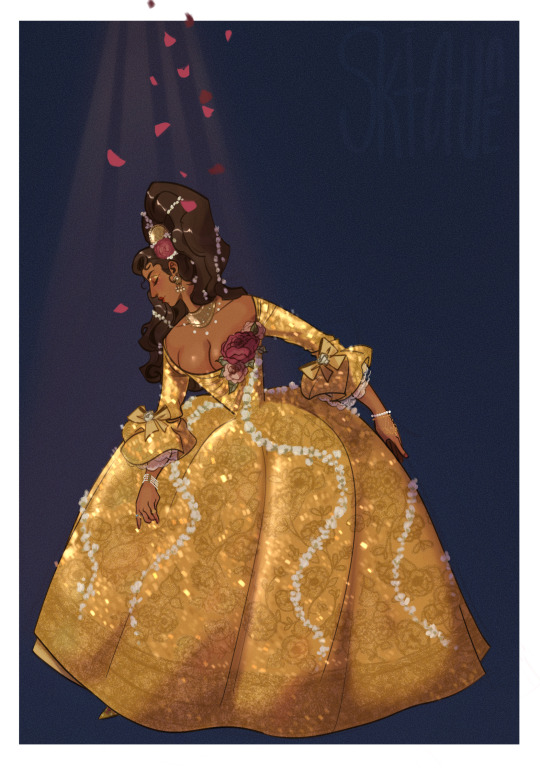
“...for it was true that she had beauty so disarming and none like any other, a mind as sharp as a blade made by Hephaestus, and a heart as gracious as a spring-kissed flower blooming under the sun’s gentle morning rays, yet the Beast could not stop himself from falling for her gentle wisdom, more for her stubborn wit, and most for her unbridled, nearly reckless courage...”
Born to a Lousanian Artist, Maurice De Beauchene, and a textile merchant from the Agarabhan city-state of Shirabad, Saundary Vishyan, Bellerose de Beauchene had always proven to be a brilliant mind with an innate understanding of engineering and machinery. She was the first female apprentice allowed entrance in the prestigious Lousanian Guild of Automatonry and Enlightened Pursuits, though she was never allowed to become an official Matoneer because of her sex.
She was known for many of her inventions, most importantly harnessing Wild Sprite (boundless and chaotic magic) into Spark, revolutionizing energy away from coal and steam, in 1798. However, what many still know her for and what many would most associate her for is her namesake—Beauty.
From her mysterious but unsurprising rise as Queen of Rosedor—the largest, richest, and most ancient of the Gaulian kingdoms and the Mecca of Daphinian Civilization, Philosophy, Invention, and Progress—to her final days, no historical recounting would dare remiss mentioning her alarming beauty, one that did not fade until the end.
Of the three historically preserved portraits available, not one was said to truly capture her beguiling visage. However, one cherished story among Rosedoreans tells of the portrait hanging in the Royal Summer Palace of Rosecoeur, where many would say that the beloved queen looked as though she was about to sneeze. It is said that Belle was notoriously bashful with regards to her looks and being painted, but that on the days that she had to sit, venerable King Adam II, would make her laugh, much to the painter’s chagrin.
Historical accounts suggest that the couple had a loving union, marked by many hushed conversations and laughter between them in any event they were invited to. Staff also remarked the couple’s sharp wit and entertaining debates at dinners, King Adam being a renowned architect himself who had studied in Richepierre, the capital of his kingdom under a common name. They were near inseparable, even in death, as Belle died two months after her husband, whom she would affectionately call “Ma Bête.”
Though there is no dearth of their relationship as leaders, in truth, much of the couple’s history is unclear with most of their supposed courtship occurring during the Great Forgetting, where the Kingdom had supposedly been enveloped in dangerous fog and briar, ceasing possible interactions with its neighboring rivals and all but deserting its role as the central trade route between East and West. The phenomenon continues to be shrouded in mystery as not even documents from other kingdoms make mention of the fabled occurrence—and more shockingly—the kingdom itself between the years 1792-1798…except for the correspondence of letters between the King and Queen themselves and their journals.
But many Rosedoreans have their own generational tale of how the Lousanian Matoneer met the Rosedorean King in the form of a Great Beast, of how their love had broken a Great Curse of disrememberance and volatile ennui. Despite the lack of historical evidence, many honor such heritage by holding balls on the Royal Couple’s anniversary and dancing Master Concerto Monsieur Guillee de Forte’s composition known as ‘La Valse de La Belle et La Bête,’ supposedly written to inaugurate the rebuilding of the Rosecoeur’s legendary ballroom during their courtship.
Many theorized that Belle would have chosen a very specific fabric, fabled to have been solely produced by her mother’s company before it burned down in 1791—colloquially named, the Solaris Weave—as the Royal seamstress, Madame Fifi De Garderobe-Forte makes mentions in her later years of making such a dress with many embellishments more accustomed to Shibarad for the exact occasion.
To this day, only a swath of the fabric exist, displayed in the Richepierre museum. At 3PM, the seemingly ordinary piece of gold fabric is placed under the sun, showing its hardly understood property to reflect fractals of light despite not being speckled or beaded. Though many to this day try to replicate the exact fabric, the national conservatory has yet to allow proper studies of the material, fearing losing it and the very heritage of Rosedor.
More Under the Cut
This piece means a lot to me being nine years in the making to the date. It may seem trivial, but I've never invested on one singular idea for as long as I had this one dress. It's one of the main reasons I've taken breaks from art in a deeply personal sense, because I would start it and finish something and hate it after two days and redo it, only to not finish anything. It was a bad cycle to say the least.
Within those years, I have grown so much in terms of knowledge and respect for fashion as a whole art form, most especially in costume design more than just historical recreation and research. At some point, I just grew tired of slapping on a robe du cour and calling it a day. I love BTAB and I love Belle and the more I felt like, simply putting on a historically accurate garment with some fantastical embellishments was half the work. So, part of this personal journey had been coming to terms of what I wanted to do.
I'd like to think that the approach I've developed for these Princess Gowns moving forward is that I want to design a dress that fits for the character at that moment in their story—who they are, what it means to be wearing that dress, and the whole context of their journey and the world they live in. It was understanding what Belle has gone through in the movie in my head, parading as producer, writer, director, AND costume designer to a fictional film stuck in my head—inspired by the greats like Sandy Powell, Terry Dresbach, and Anthony Powell and Rosemary Burrows.
It includes having an understanding of her character, of how she relates to others, of world building, and even the fashion CULTURE of the region at large, because by then, I had completely forgone trying to write a story WITHIN our world and found so much more possibilities by writing these Disney stories outside of our world and reality.
So, we have this dress. A glittery gold dress of dreams that has been nine years in the making, a dress that represents Belle at that pinnacle moment—and maybe even my own 'closing of the book,' if you will.
I designed this gown with a healthy understanding that throughout her 2-3 year stay in the castle and forest, she would have had so many dresses of so many colors and styles. I was focused more on contextualizing different decades of 18th century fashion to become region fashions with the redingote and a la Turque being something more used in the kingdom's capital, while more pastoral a la reigne being what could have been 'it' with the court, amongst others.
A lot of this dress was designed with the rest of her wardrobe in mind in an attempt to differentiate it from others. No other gown will have the same neckline, the same silhouette, the same volume, and the same color. Not even her hair and makeup would be similar to the other dresses. So, it feels like a 'step forward' in fashion within the trends and context set up in the story by all the other gowns worn by her and others.
For Belle's dress, I gravitated towards the silhouettes of the 1730s-40s, where the hip wasn't too angular and flowed more naturally like a...bell (that's an unintentional pun). I think that it's the more pleasing option, though Belle would be wearing more panniers throughout the story too. I wanted something that made the Waltz (which in this universe, had already been developed) elegant and not too cumbersome and panniers just felt too bulky, because the dances associated with it didn't need close contact. So, in the mechanics sense, I found that this would work best.
I maintained a dose fo 1950s-60s references in my head. I would love Belle to wear something like a re-imagined Dior New Look gown while strolling with Adam in the greenhouse or pull up Lacroix for dinner, de Garderobe being a very 'keen' fashion innovator with Belle as her muse.
But in my story, she would stay away from one specific color—yellow/gold. It was her mother's color and, in grieving, she refused to touch it and anything that could harken back to her mother, like south-asian style embroidery and motifs. But I think as Belle develops her own style and the more Adam and her bond, the more she comes to terms with her mother's death.
There's a lot to the story I can't share at the moment, of how they meet and how they bond, and why they're stuck in the forest. There's too much to discuss, but be assured that a lot had been retconned.
So this dress was her 'bringing' her mom to meet the man she fell in love with, even if she can't admit it. It's her coming to terms with what happened and carrying her mother with her instead of looking back with nothing but heartbreak.
And she looks damn good with her mama's color, I'll tell you that much. I know that on one hand, gold can be a color of greed and temptation, but for me, I think gold is 'pure' and 'luminous.' I wanted her intentions, those she cannot find the courage yet to speak, be clear and transfixing.
Another aspect was the symbolism of her and Adam's relationship. I know that flower garlands were in use in some gown throughout the 1750s-60s. I also know Lehengas are sometimes worn with a copious amount of flower garlands too, so I had this idea of just overflowing her dress with jasmines, which are a very common fixture even here in the Philippines with a context of spirituality as we usually put it on sacred images and statues. So, while on the shallow sense, it may come as a merging of two cultures, for me, there's a bit of sanctity, the same image evoked as Belle and the Beast danced under heavens and smiling cherubs.
In a story sense, the rose on her left chest represents her heart blooming for Adam, as if sprouting forth the gold, illuminating her like the sun as he is her sky...her space. It's as much a love letter to him as it is to herself and her mother, because I wanted to emphasize her POV in their story too, of how she felt safe and loved, away form ridicule and prejudice.
And lastly, the hair. Okay, so part of the journey was figuring out her hair. With a 1950s facade, for the longest time I focused on maintaining the curls of the rococo period and conflating it a lot with the waves of the 1950s, so you will see a lot of sketches with that. It wasn't until I tried understanding the overall silhouette of court fashion that I had my eureka moment and realize that the volume was more important than what's...within said volume. And, funnily enough, after trying SO HARD to avoid the hair bun...I ended up with a hairstyle that unintentionally pays homage to it.
My only regret is not finding a way to highlight the shoes HAHAHHAHAHA. I'm mad, because I really wanted to draw the shoe but I didn't want to ruin the way the gown flowed already.
TIMELINE
2016-2017: "Bitch, They've Hit the Pentagon."

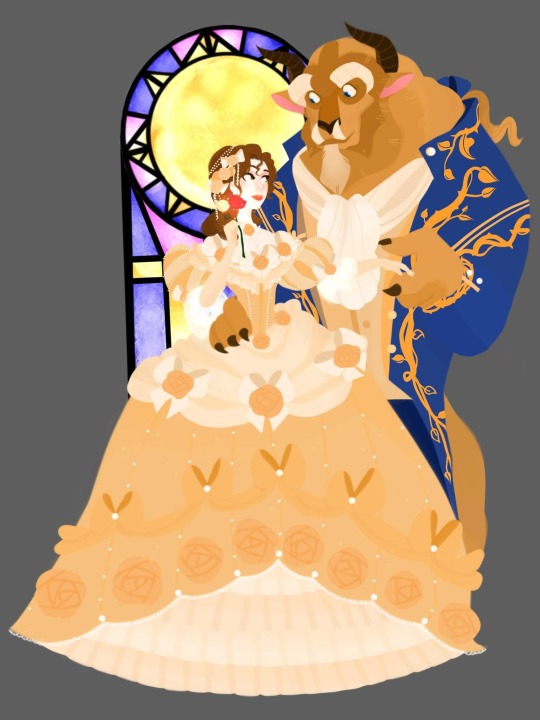
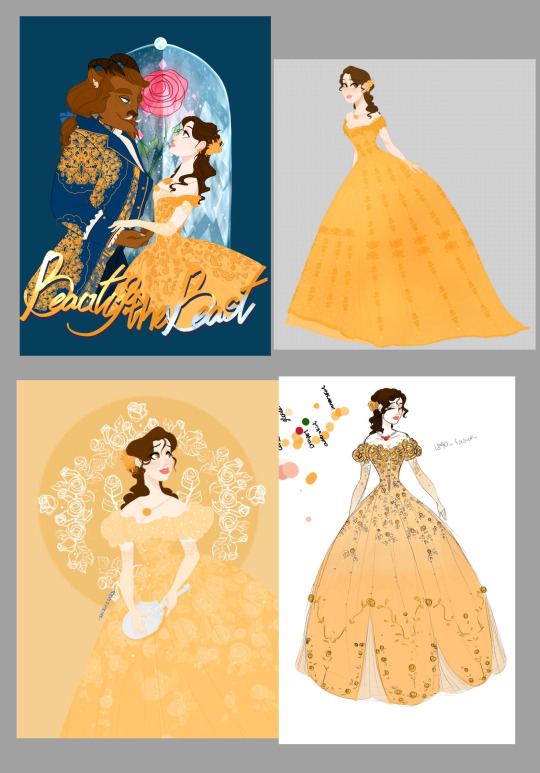
As a kid, I was always exposed to fashion magazines since my mom used to be subscribed to a whole lot of them. I would look at Harper's Bazaar and Vogue, smell the perfume samples that came with them. I've always had a sort of inherent, passive interest in fashion but not enough to know the designers and the motifs.
But then, I saw a leak of Belle's gown in the 2017 version and...I lost it. I was convinced I would do a better job designing it, but hell, I think anyone would. Back then, i was obsessed with simply remaking the original dress and making it 'pretty.' Of course, as you can see, I based some on the broadway gown and afterwards, it sorta developed into this romantic, 2000s punk dress with lace fingerless gloves and whatever. HAHHAHAHA, at that time, I didn't really care for 18th century fashion...so...
2018: "Roco-NO? I think you mean, Marie Antion-YAS!"
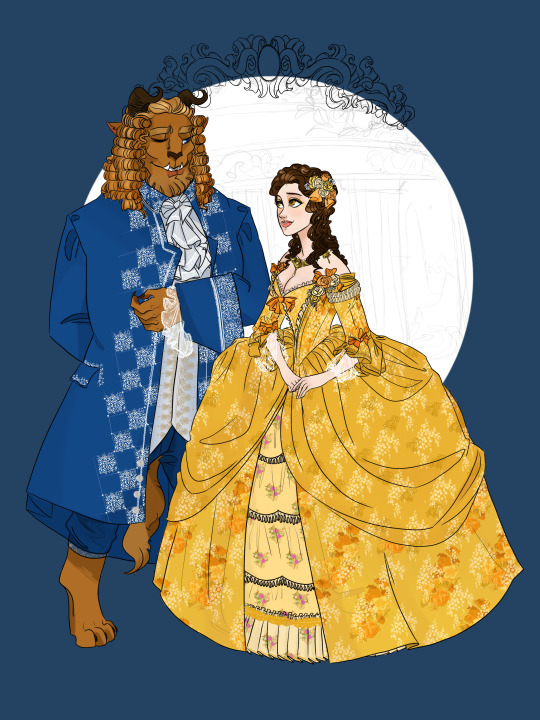
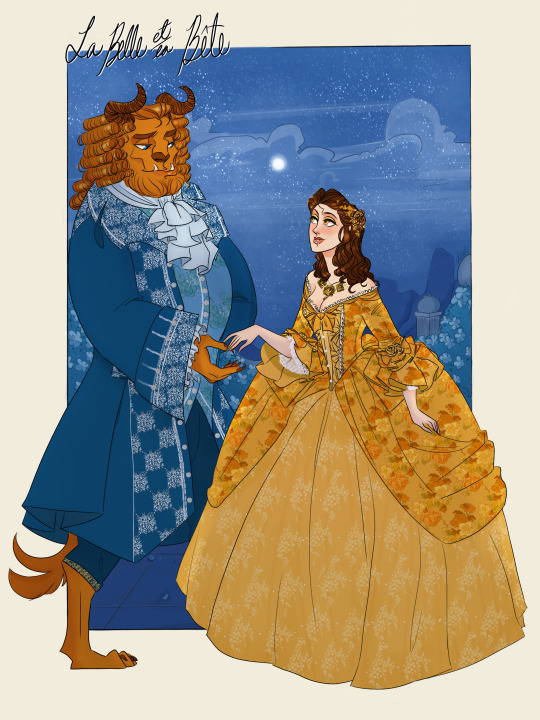
I think the biggest step during this era was me falling in love with the fashion of the 18th century. I was exposed to Outlander and other shows and I started watching youtube videos deep-diving into court fashion, so I started veering away from anything vaguely 1840s-60s and literally went a hundred years BACK.
Sadly, it came with hang ups too. IDK what the hell I was doing with faces, honestly? Also, I was really forcing the off-the-shoulder V-boob neckline far too much, even when it was...very hard to make sense off construction-wise.
2019-2021: "Wait a minute...Desi...Belle?"
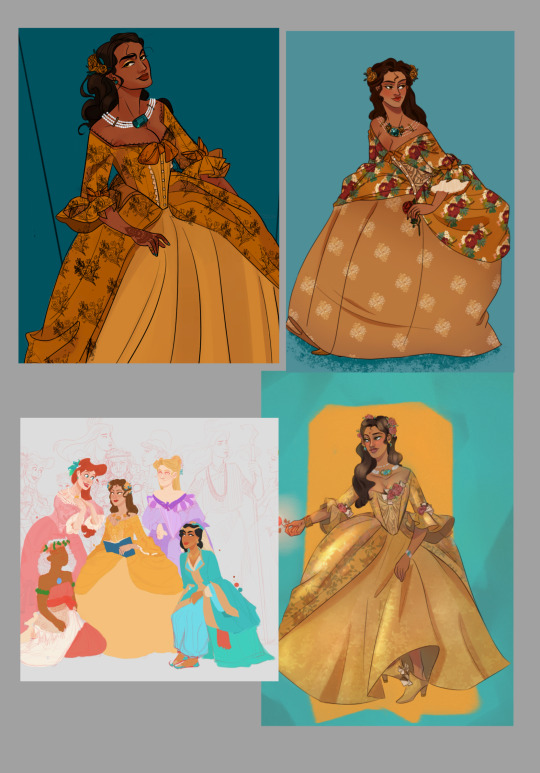
At this point, I've fleshed out the story in my head for more diversity, not just because diversity matters, but I wanted more things to be different in the settings and the world the Disney Heroes are based in. I wanted the idea that trade and intermingling of cultures was far more common and recognized and I thought that Belle being biracial was a good choice, and something I related to.
I guess that's what was the most important development during this period. Though note how I initially wanted her to have henna on her hands but I decided that that would be better at the wedding. In addition, there was little effort to make the actual gown reflect her heritage.
2022-2023: "Screw it, I give up!"
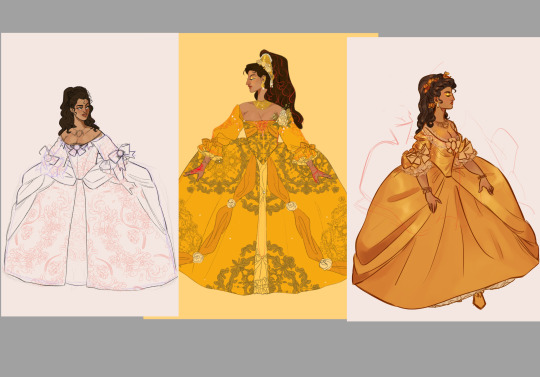
During this time, I was doing my internship, so I lost interest in designing and art in general. It was just hard to concentrate, really, but still, I think that there were a lot of aspects to these deigns that ultimately lead me to the final design.
2024-NOW: "And They All Lived..."
So now, we're here at the present. It's been such a long time coming and I feel relief to be able to share this and move on, so to speak. Even if I have a lot of creative energy and a better relationship with my art, I've come to realize that I can't make a dress I love without having a whole ass story to fantasize about.
Sure, I have a few designs for the other princesses with their own huge stories that make it easy to find direction, but I can't confidently say that I would want to keep making stories for all princesses moving forward. I would love to, of course, but I don't want that to be the whole reason for my blog to catch attention.
Keep your eyes peeled for more disney gowns, but I do hope you stay for some other projects i want to do, maybe some muscle daddies in cute dresses, fashion designs I wish were on the National Costume category for Miss Universe or DRPH, and maybe some studies here or there and gay pinups.
I hope that for those who have stayed here reading all of this to have a wonderful day and to never stop creating and chiseling away at your block of marble.
Maraming Salamat!
#my art#fashion#art#disney#belle#disney princess#historical fashion#costume design#costume redesign#elseworld#beauty and the beast#rococo#desi#fashion illustrations#fashion design#disney fanart#gold
22 notes
·
View notes
Photo

Diversity in Church Architecture in Medieval England
Medieval English churches differed in size and layout. Their original and evolving role(s), financial and material resources, and architectural fashions helped determine variability. However, their look ultimately grew from a constant symbiosis between being a place for worship and practical matters. During the 10th-15th centuries, stone construction became firmly established, and that witnessed a golden era of church building.
Purpose & Resources
Immediate, mundane reasons for diversity were just as for any other buildings – houses, castles, offices – it depended on the purpose for which they were originally built and the financial and material resources available to the initial builders and to later owners who wanted to extend and/or beautify it.
Impoverished communities created basic churches employing the means and materials members of the settlement possessed or could source nearby using their own sweat and skills. Rich sponsors had the wherewithal to envisage and execute the most lavish projects money and authority could buy, transporting materials from far and wide, engaging the leading designers, technology, masons, metalworkers, carpenters, painters, and glaziers of the day.
Basic buildings might be erected as outposts of mother churches/minsters or by individual villages or minor landowners wanting a place, however humble, to express their faith, as a centre for the daily, weekly, and yearly cycles of devotion that dominated and led peoples' lives. They were simple rectangular structures, large enough for maybe 15 to 20 worshippers. The grandest undertakings were sponsored by major royal, aristocratic, or religious order benefactors to produce leading centres of ecclesiastical, administrative, and scholarly influence. Many of the great cathedrals, abbeys, and minsters, like Durham, Lincoln, and Old St Paul's London were wonders of the world at the time they were built, well over 100 meters long, 100 meters high, or more, and tens of meters wide.
Of course, the majority of churches fell in between these extremes. Some might not initially have been conceived on a grand scale, yet over the centuries they grew as patrons and communities responded to changing population sizes and advances in building technology that fed the desire to always have the bigger, better, more beautiful, the latest architectural fashion. In the economic climate of the later Middle Ages, fresh sponsors of church building and extension entered the scene. Newly rich guilds and merchants in many towns employed their wealth to craft ornate chapels or enhance an existing church with which they were associated. From unpretentious origins, many modest buildings thus grew into impressive houses of God – witness Leicestershire's grandest church in Melton Mowbray backed by wool traders' money, and the great wool churches of Norfolk and Suffolk.
Continue reading...
30 notes
·
View notes
Text
With the Abyssal portions defeated, time for the final thoughts on Nexomon Extinction.
The Abyssals are exactly what I wanted out of the Tyrants.
My biggest complaint story-wise for this game was that the Tyrants themselves really didn't matter much. There's a thousand-year war among the Tyrants going on, that pushed humanity so far that one Guild leader created a cult to revive Omnicron, and their successor created artificial dragons to hunt Tyrants, an artificial Tyrant to command them, and then another, bigger one when that plan failed. But despite how significant this war was...all of the Tyrants we meet are pretty inconsequential, and most are associated with a human who does most of the talking and planning to begin with. I understand that this game is the human errors side of thing after the last game's presentation of the threat of Nexomon, but it's still kinda rough to go through all these story segments with the Tyrants not producing anything substantial. You get to postgame where you can hunt them down, and they're all a pain in the ass to find, with nothing drawing me to them.
The Abyssals, though? This is what I wanted. A thousand years ago, the first Abyssal arrived. And their first act? Killing Hilda. Another is stated to have made an attempt on Eliza's life. These are a much more pressing, salient threat. Sure, Tyrants destroyed cities, but we've never seen them do anything. The Abyssals have personal connection.
Despite their power, the Abyssals are odd in that they never aimed to become Sovereign of Monsters, and they seem immune to Solus' influence as the current Queen. What's presented is a pretty interesting mystery that builds up more questions than it feels like it wants to answer. What's the deal with these weird engravings? Why are Abyssals so weird? Apparently each is born with a clear goal from its creator, but this creator is unknown to them, and their specific goals are incredibly simplistic, with no known overarching goal. They're super unusual.
By gameplay, the Precursor Island is really fun. It might be an odd comparison, but it reminds me of the bonus dungeon of Ib a bit. There's a central location, and your goal is running around everywhere to collect the things you need to progress, solving puzzles that sometime intertwine a bit. It's a really fun system, finding each of the Abyssals and solving their puzzles. The only annoying ones were the flying one (Inominox) and the electric one (Volcel). The rest was really fun. Even the weird maze puzzle was fairly clever, though the final solution was a little...obvious but still hard to figure out the hint.
I think what really sells me on the Abyssals...well, two things. The smaller one is design. The Abyssals are just really cool concepts. Venefelis shows up and is immediately incredible, being super imposing but kinda goofy, and stated outright that he shouldn't be strong enough to pull off the nonsense he has. Kroma is my absolute favorite, and she's set up as super imposing given her drive is killing Eliza, only for Venefelis to rant about how incompetent Kroma is for being the only one of them to fail in her mission. Then there's Screaming Fire Velociraptor, who is hilarious in concept. And Inominox, who is such a coward that it won't face anyone with more than one Nexomon, and that one Nexomon needs to be weak to Flying. Or the soup for Volcel. There's Caelesa, who ran across the world, and was attacked by the Guild for little reason other than paranoia, since she hurt no one in her efforts. There's Pluvian, whose entire goal was to show up, scream, and then get killed by the Guild for no clear reason. There's Rotrimus, who you try to order around, and initially agrees, but is intercepted by the force of their creator bending its will back to refusing your call. It's a really interesting and dynamic group, that apparently has no clear association. Many of them insist they worked alone. They had a creator, but they themselves don't even think of themselves as a unified group. Only Venefelis seems to confirm that they have association.
The other is that this group is delightfully aligned to the themes of the game. Nexomon Extinction has two general themes I can identify. The first is a bit more obvious and repeatedly stated: second chances. The children of Omnicron refer to their support as their redemption, the entire plot is Deena attempting to grant a second chance at saving the world, your resolution of the central conflict is trading the destruction of your direct enemy into granting them a second chance at life. There's an ongoing importance to the idea of getting a second shot at things...but a second shot isn't necessarily going to mean doing better. The former hero comments that your actions amount to the same thing she did, and despite the failures of the dragons, Amelie's second chance is doubling down on a decision that worked out poorly. This leads into the second theme, and the one I like a lot better: the limits of personal agency.
The former hero is a good lens for this one. Repeatedly throughout this game, their actions are referred to as if it was a huge mistake. They themselves talk about it as a mistake. Deena outright calls it stupid decision made by her moronic friends. Even Ulzar, who is more sympathetic to the situation, talks about it as if it were a mistake, if an understandable one. Absolutely everyone treats their actions as something that led to the present problem, and thus was the wrong decision.
But...we were there. Omnicron was going to completely destroy the world. You can argue that the destruction of his soul in the netherworld wasn't necessary, and that was the mistake. But it's well known that he'll come back time and again; it'd be pushing the problem out to the next generation. And Omnicron could follow through. When you fail to destroy him in the Netherworld, Omnicron devastates an area so badly that entire maps are wiped out of reality. This was done in hours. Omnicron tells you outright he could've annihilated the planet in a day, but he stopped solely to challenge his rival, the strongest human, as a matter of pride. This wasn't an idle threat. It was an active, immediate devastation looming on the horizon.
Faced with that, what choice did you really have? Yes, there was a technically a choice. But who could choose the alternative? When humanity is faced with its destruction through the war of the Tyrants, yes, you had a choice to make those dragons or not. But faced with the destruction of multiple cities and further looming threat, what choice did you have? When those failed, you had the choice to stop. But then the destruction of the Tyrants continue unabated. Who would choose to stop? Vados embodies this. He's a creation of Amelie, born to hunt Tyrants to protect humanity. The thing about Vados is that he has agency and beliefs of his own. When told to destroy Petram in spite of the Laterians interfering, he refuses to harm humans. But we know that will happen anyway. We're told repeatedly that the Tyrants will continue to rise, until Vados has destroyed so much that the world is inhospitable to humans as well. He has his own agency, his own desire to protect humanity and protect the world. But he'll betray that through his own actions, regardless of what he wants. He was made to hunt Tyrants, and so he shall, til the end of days. The only way to avert this is to refuse to fight every Tyrant, to refuse to wage this absolute crusade. And that's the only choice he cannot make. He doesn't get a choice.
The Abyssals continue this theme. Like Vados, the Abyssals are created for a singular purpose. They are born with a goal, and that is all they have. They have their own personalities, but few of them seem interested in the specifics of what's going on. Kroma doesn't seem particularly interested in killing Eliza, she just has to. Pluvian doesn't seem to function as a willing sacrifice, but she does it anyway because that's her goal. Regardless of what they want, they will carry out their goal.
Unlike Vados, though, they have no overarching philosophy. Nothing that specifically guides their actions beyond the immediate. Caelesa runs around the world, but she doesn't seem to understand why. So when their goal is accomplished, despite getting a second chance at life...none of them know what to do with it. So they just sit around, completely docile, until you strike them down again. What other choice did they have? They never knew what they were aiming to do in the first place.
Except for Venefelis. The first Abyssal. At first, he had no idea what his point was. He had a goal, carried it out, and got sealed within the woods forever. Not ideal, but mission accomplished. Then 300 years later, another entity like him appears, carrying out a similarly short-sighted goal. Then 200 years later, another. And another 100 years after that. They appear faster and faster, until we get two within ten years. And as the only one to really survive, even if just as a spirit...you recognize the pattern. After all, Venefelis understands Caelesa's goal better than she understands it herself. She thinks it was just running, but Venefelis identifies it as a scouting mission. You know there's a grander design here; a purpose. But you can't figure out what. Because no one will tell you. You creator, the one guiding your motions, won't speak to you.
What else can you do but try to divine their intent? With nothing else to go off of, you watch their actions, and notice only one thing stands out. Kroma failed, and following that, no other Abyssals were created. Maybe your creator quit. Maybe it's because of Kroma. You don't know that, but what else could it be? You don't understand your purpose, but you desperately want to understand it; to know why you're still here. What choice do you have but to force a second chance on her? To enforce your creator's will, regardless of what she'd want? What choice does she have but to obey?
The twisted thing is, there really is nothing else for them. Rotramus shows this definitively. When you attempt to issue a command, he thinks about it, and passively decides sure, I'll help. It's not the resounding success of an authority check commanding its allegiance. It's someone making a choice, as if it has nothing better to do and no reason to argue. But its creator's will forces it to refuse. Even with its goal accomplished, and no reason to refuse, they interfere, denying your freedom. Quite literally, you have no other choice.
Everything that happens in this arc is driven by Venefelis' desires. His agency, his desire to understand his creator, drives everything forward. No one else even understands why they're here. They didn't have much choice either way. He brought them back, gave them a second chance they had no use for. But what else could he have done? To see what he wanted done, all he could do was solve Kroma's failure by pushing her into another attempt. And it wouldn't have even worked. It was entirely for nothing. But what can you do but try? You technically have a choice. You finished your goal, you could just let it all rest. But faced with the dread of an eternity devoid of purpose, who would choose any different?
Despite how many open-ended threads there are, and how many mysteries we're left with, this does feel like a self-contained story. We don't know what the point is. We don't know what it means. But neither did they. And the result of that ignorance, that impossibility, is they existed unable to live for themselves, and no second chance could get them to defy that fate. Which really resonates with me. I loved this side story a lot, and these open questions have really gotten me interested in the sequel game. I've heard they officially announced its existence but not a release date or any details. I can be patient. But I'm really invested in this one. They really hit a sweet spot here.
19 notes
·
View notes
Text

Nate Long (April 6, 1930 - November 14, 2002) was a filmmaker, television producer, director, stuntman, actor, and teacher who worked both in Hollywood and the Pacific Northwest. He was born in Philadelphia. He joined the Air Force, became a military policeman, and completed his service at Paine Field. While in the Air Force, he earned a black belt in judo. He taught judo and karate to children through Seattle’s Central Area Motivation Project.
His interest turned to mass media and he created Oscar Productions, a Seattle-based photography, cinematography, and television production training program for inner-city high school and college students. He and his students produced a weekly public affairs program, Action Inner City, and a monthly show titled Aggin News.
He produced two award-winning television series videotaped in the Pacific Northwest. The first was South by Northwest, produced, and the sequel was The Second Time Around. Both series, funded by the US government, chronicled the lives of African American settlers in the Pacific Northwest. South by Northwest was one of the first productions to use videotape to record exterior scenes.
It earned the Corporation for Public Broadcasting Award and the New York Film Festival Award. He became one of the early African American second unit directors in the motion picture industry. His second unit director credits included The Slams, Mr. Billion (aka The Windfall), and Over the Edge. He worked on the feature film Tex, thus becoming the first African American selected to be a second unit director for a Walt Disney film.
He performed stunts in Tex, Mr. Billion, and The Slams, as well as Hit Man, Truck Turner, and White Line Fever. He was the stunt coordinator for Tex and White Line Fever. He was a member of the Directors Guild of America, the Academy of Television Arts and Sciences, the Association of Black Motion Picture and Television Producers, and the Alliance of Black Entertainment Technicians.
He designed and implemented the first two-year film program at Seattle Central Community College. He established and managed similar media programs at TSU and Texas A&M University. #africanhistory365 #africanexcellence
4 notes
·
View notes
Text
Alissa Wilkinson at Vox:
The Hollywood writers strike marked its one-month anniversary on Friday, with no signs of slowing down. While other guilds in the industry are still on the job — except when they’re blocked by picket lines — the writers may soon get company on those picket lines.
Two other major entertainment guilds, the Directors Guild of America (DGA) and Screen Actors Guild (SAG-AFTRA), also entered the summer with looming contract expiration dates. Both groups’ agreements with AMPTP, the trade association that represents the industry’s film and TV production companies, end on June 30. A lot could happen between now and then, but the situation is looking dicey.
All of that means that come July 1, the studios may be facing a double or even triple strike, in effect shutting Hollywood down completely.
The DGA rarely strikes — the last time was in 1987 — and its leadership has not called for a strike authorization vote. But its relations with the AMPTP have been trickier than usual. Negotiations began on May 10, with demands that in part mirror the WGA’s concerns. The main sticking point is wage and residual increases that keep in step with rising costs of living. In particular, lower residuals for shows on streaming services, where the lion’s share of entertainment now lives, have wreaked havoc for many people in the industry, drastically reducing compensation and making it increasingly difficult to just pay the bills.
In the past, the DGA has sometimes managed to make an agreement with AMPTP ahead of the start of bargaining, effectively setting a pattern for the WGA and SAG-AFTRA to follow in their own demands. Last November, the DGA sent a “pre-negotiation” offer to the AMPTP, seeking resolution ahead of bargaining. The AMPTP reportedly rejected the DGA’s proposal, meaning both parties came to the bargaining table without an arrangement.
The situation seemed to intensify due to an unforced error. On May 23, Warner Bros. Discovery launched Max, its newly rebranded streaming platform, which had previously been named HBO Max. Eagle-eyed observers noticed that in listed credits, the platform lumped writers, directors, producers, and so on into one category labeled “creators.” Aside from the queasy implications that the greatest works of cinema and television were just “content,” the choice on the company’s part ran afoul of hard-fought contract regulations regarding credits for artists.
It was a weird choice, and one that set blood boiling in Hollywood. The presidents of the WGA and the DGA issued a rare joint statement, with DGA president Lesli Linka Glatter noting that “The devaluation of the individual contributions of artists is a disturbing trend and the DGA will not stand for it. We intend on taking the strongest possible actions, in solidarity with the WGA, to ensure every artist receives the individual credit they deserve.”
By the end of the day, Warner Bros. Discovery announced that it would modify how credits were listed on the platform in compliance with its preexisting contract agreement with the unions. Yet the strong language indicated that the DGA was ready to play hardball.
Meanwhile, members of SAG-AFTRA have been vocally supportive of the WGA. This is no shock, since on top of the same issue of residuals and wages, the union — which includes, in addition to film and TV actors, people who work in radio, singers, voice actors, influencers, models, and other media professionals — is concerned about the existential threat posed by AI and other technologies. Even before the WGA’s strike began, SAG-AFTRA issued statements regarding how the use of AI could eliminate or greatly reduce work for its members.
Members of SAG-AFTRA have shown up on picket lines to support the writers, and the star power posed by some of its most prominent members helps bring attention to the WGA’s strike. It’s also an effort to remind the studios that when their own negotiations begin, they’re ready for a fight. Underlining that implicit statement, the leadership of SAG-AFTRA unanimously agreed to ask its membership for a strike authorization vote, which concludes this coming Monday, June 5. That’s a move designed to signal solidarity to the AMPTP ahead of negotiations.
[...]
Here’s what’s most significant about all of this: All three unions have never gone on strike at the same time, in the history of Hollywood. The fact that this scenario is possible, even likely, emphasizes how extraordinary this moment is in the entertainment business.
Hollywood could be on the verge of a triple strike that could effectively shut down everything completely. The WGA strike is ongoing, but the SAG-AFTRA and/or the Directors Guild could also launch their own strikes.
#WGA Strike#WGA#2023 WGA Strike#SAG AFTRA#Directors Guild of America#Strikes#Labor#2023 SAG AFTRA Strike#Max#HBO Max#Streaming#Television
68 notes
·
View notes
Text

Chapter 9: Conclusion
If we take now the teachings which can be borrowed from the analysis of modern society, in connection with the body of evidence relative to the importance of mutual aid in the evolution of the animal world and of mankind, we may sum up our inquiry as follows.
In the animal world we have seen that the vast majority of species live in societies, and that they find in association the best arms for the struggle for life: understood, of course, in its wide Darwinian sense — not as a struggle for the sheer means of existence, but as a struggle against all natural conditions unfavourable to the species. The animal species, in which individual struggle has been reduced to its narrowest limits, and the practice of mutual aid has attained the greatest development, are invariably the most numerous, the most prosperous, and the most open to further progress. The mutual protection which is obtained in this case, the possibility of attaining old age and of accumulating experience, the higher intellectual development, and the further growth of sociable habits, secure the maintenance of the species, its extension, and its further progressive evolution. The unsociable species, on the contrary, are doomed to decay.
Going next over to man, we found him living in clans and tribes at the very dawn of the stone age; we saw a wide series of social institutions developed already in the lower savage stage, in the clan and the tribe; and we found that the earliest tribal customs and habits gave to mankind the embryo of all the institutions which made later on the leading aspects of further progress. Out of the savage tribe grew up the barbarian village community; and a new, still wider, circle of social customs, habits, and institutions, numbers of which are still alive among ourselves, was developed under the principles of common possession of a given territory and common defence of it, under the jurisdiction of the village folkmote, and in the federation of villages belonging, or supposed to belong, to one stem. And when new requirements induced men to make a new start, they made it in the city, which represented a double network of territorial units (village communities), connected with guilds these latter arising out ofthe common prosecution of a given art or craft, or for mutual support and defence.
And finally, in the last two chapters facts were produced to show that although the growth of the State on the pattern of Imperial Rome had put a violent end to all medieval institutions for mutual support, this new aspect of civilization could not last. The State, based upon loose aggregations of individuals and undertaking to be their only bond of union, did not answer its purpose. The mutual-aid tendency finally broke down its iron rules; it reappeared and reasserted itself in an infinity of associations which now tend to embrace all aspects of life and to take possession of all that is required by man for life and for reproducing the waste occasioned by life.
It will probably be remarked that mutual aid, even though it may represent one of the factors of evolution, covers nevertheless one aspect only of human relations; that by the side of this current, powerful though it may be, there is, and always has been, the other current — the self-assertion of the individual, not only in its efforts to attain personal or caste superiority, economical, political, and spiritual, but also in its much more important although less evident function of breaking through the bonds, always prone to become crystallized, which the tribe, the village community, the city, and the State impose upon the individual. In other words, there is the self-assertion of the individual taken as a progressive element.
It is evident that no review of evolution can be complete, unless these two dominant currents are analyzed. However, the self-assertion of the individual or of groups of individuals, their struggles for superiority, and the conflicts which resulted therefrom, have already been analyzed, described, and glorified from time immemorial. In fact, up to the present time, this current alone has received attention from the epical poet, the annalist, the historian, and the sociologist. History, such as it has hitherto been written, is almost entirely a description of the ways and means by which theocracy, military power, autocracy, and, later on, the richer classes’ rule have been promoted, established, and maintained. The struggles between these forces make, in fact, the substance of history. We may thus take the knowledge of the individual factor in human history as granted — even though there is full room for a new study of the subject on the lines just alluded to; while, on the other side, the mutual-aid factor has been hitherto totally lost sight of; it was simply denied, or even scoffed at, by the writers of the present and past generation. It was therefore necessary to show, first of all, the immense part which this factor plays in the evolution of both the animal world and human societies. Only after this has been fully recognized will it be possible to proceed to a comparison between the two factors.
To make even a rough estimate of their relative importance by any method more or less statistical, is evidently impossible. One single war — we all know — may be productive of more evil, immediate and subsequent, than hundreds of years of the unchecked action of the mutual-aid principle may be productive of good. But when we see that in the animal world, progressive development and mutual aid go hand in hand, while the inner struggle within the species is concomitant with retrogressive development; when we notice that with man, even success in struggle and war is proportionate to the development of mutual aid in each of the two conflicting nations, cities, parties, or tribes, and that in the process of evolution war itself (so far as it can go this way) has been made subservient to the ends of progress in mutual aid within the nation, the city or the clan — we already obtain a perception of the dominating influence of the mutual-aid factor as an element of progress. But we see also that the practice of mutual aid and its successive developments have created the very conditions of society life in which man was enabled to develop his arts, knowledge, and intelligence; and that the periods when institutions based on the mutual-aid tendency took their greatest development were also the periods of the greatest progress in arts, industry, and science. In fact, the study of the inner life of the medieval city and of the ancient Greek cities reveals the fact that the combination of mutual aid, as it was practised within the guild and the Greek clan, with a large initiative which was left to the individual and the group by means of the federative principle, gave to mankind the two greatest periods of its history — the ancient Greek city and the medieval city periods; while the ruin of the above institutions during the State periods of history, which followed, corresponded in both cases to a rapid decay.
As to the sudden industrial progress which has been achieved during our own century, and which is usually ascribed to the triumph of individualism and competition, it certainly has a much deeper origin than that. Once the great discoveries of the fifteenth century were made, especially that of the pressure of the atmosphere, supported by a series of advances in natural philosophy — and they were made under the medieval city organization, — once these discoveries were made, the invention of the steam-motor, and all the revolution which the conquest of a new power implied, had necessarily to follow. If the medieval cities had lived to bring their discoveries to that point, the ethical consequences of the revolution effected by steam might have been different; but the same revolution in technics and science would have inevitably taken place. It remains, indeed, an open question whether the general decay of industries which followed the ruin of the free cities, and was especially noticeable in the first part of the eighteenth century, did not considerably retard the appearance of the steam-engine as well as the consequent revolution in arts. When we consider the astounding rapidity of industrial progress from the twelfth to the fifteenth centuries — in weaving, working of metals, architecture and navigation, and ponder over the scientific discoveries which that industrial progress led to at the end of the fifteenth century — we must ask ourselves whether mankind was not delayed in its taking full advantage of these conquests when a general depression of arts and industries took place in Europe after the decay of medieval civilization. Surely it was not the disappearance of the artist-artisan, nor the ruin of large cities and the extinction of intercourse between them, which could favour the industrial revolution; and we know indeed that James Watt spent twenty or more years of his life in order to render his invention serviceable, because he could not find in the last century what he would have readily found in medieval Florence or Brügge, that is, the artisans capable of realizing his devices in metal, and of giving them the artistic finish and precision which the steam-engine requires.
To attribute, therefore, the industrial progress of our century to the war of each against all which it has proclaimed, is to reason like the man who, knowing not the causes of rain, attributes it to the victim he has immolated before his clay idol. For industrial progress, as for each other conquest over nature, mutual aid and close intercourse certainly are, as they have been, much more advantageous than mutual struggle.
However, it is especially in the domain of ethics that the dominating importance of the mutual-aid principle appears in full. That mutual aid is the real foundation of our ethical conceptions seems evident enough. But whatever the opinions as to the first origin of the mutual-aid feeling or instinct may be whether a biological or a supernatural cause is ascribed to it — we must trace its existence as far back as to the lowest stages of the animal world; and from these stages we can follow its uninterrupted evolution, in opposition to a number of contrary agencies, through all degrees of human development, up to the present times. Even the new religions which were born from time to time — always at epochs when the mutual-aid principle was falling into decay in the theocracies and despotic States of the East, or at the decline of the Roman Empire — even the new religions have only reaffirmed that same principle. They found their first supporters among the humble, in the lowest, downtrodden layers of society, where the mutual-aid principle is the necessary foundation of everyday life; and the new forms of union which were introduced in the earliest Buddhist and Christian communities, in the Moravian brotherhoods and so on, took the character of a return to the best aspects of mutual aid in early tribal life.
Each time, however, that an attempt to return to this old principle was made, its fundamental idea itself was widened. From the clan it was extended to the stem, to the federation of stems, to the nation, and finally — in ideal, at least — to the whole of mankind. It was also refined at the same time. In primitive Buddhism, in primitive Christianity, in the writings of some of the Mussulman teachers, in the early movements of the Reform, and especially in the ethical and philosophical movements of the last century and of our own times, the total abandonment of the idea of revenge, or of “due reward” — of good for good and evil for evil — is affirmed more and more vigorously. The higher conception of “no revenge for wrongs,” and of freely giving more than one expects to receive from his neighbours, is proclaimed as being the real principle of morality — a principle superior to mere equivalence, equity, or justice, and more conducive to happiness. And man is appealed to to be guided in his acts, not merely by love, which is always personal, or at the best tribal, but by the perception of his oneness with each human being. In the practice of mutual aid, which we can retrace to the earliest beginnings of evolution, we thus find the positive and undoubted origin of our ethical conceptions; and we can affirm that in the ethical progress of man, mutual support not mutual struggle — has had the leading part. In its wide extension, even at the present time, we also see the best guarantee of a still loftier evolution of our race.
#organization#revolution#mutual aid#anarchism#daily posts#communism#anti capitalist#anti capitalism#late stage capitalism#anarchy#anarchists#libraries#leftism#social issues#economy#economics#climate change#anarchy works#environmentalism#environment#solarpunk#anti colonialism#a factor of evolution#petr kropotkin
15 notes
·
View notes
Text
Taking a French revolution class in the middle of the American shitshow is insane. 'Free market' capitalism was supposed to be freedom from guilds-- organized workers who demanded quality out of their apprenticeships. And... instead it's a power of the middleman merchant? Who needs no association with skilled guild workers because he can use unskilled labor to produce large quantities with no quality, all for a lower price that these new low-wage workers will have to buy in their own desperate poverty?
And two hundred years later I'm the same worker. And I'm buying the same cheap products. And I wish I could support skilled businesses more but it breaks the bank. And the merchants are still singing their stupid Enlightenment woes about 'equality' that free market capitalism gives us all. And I think, organization of workers was so much better. I know we paid all the stupid taxes for the rich but at least we got quality things to like sometimes. At least if I bought a cabinet I knew it would last my whole life. I can't believe feudalism looks better than this. I should at least have a knight to pay taxes to
4 notes
·
View notes